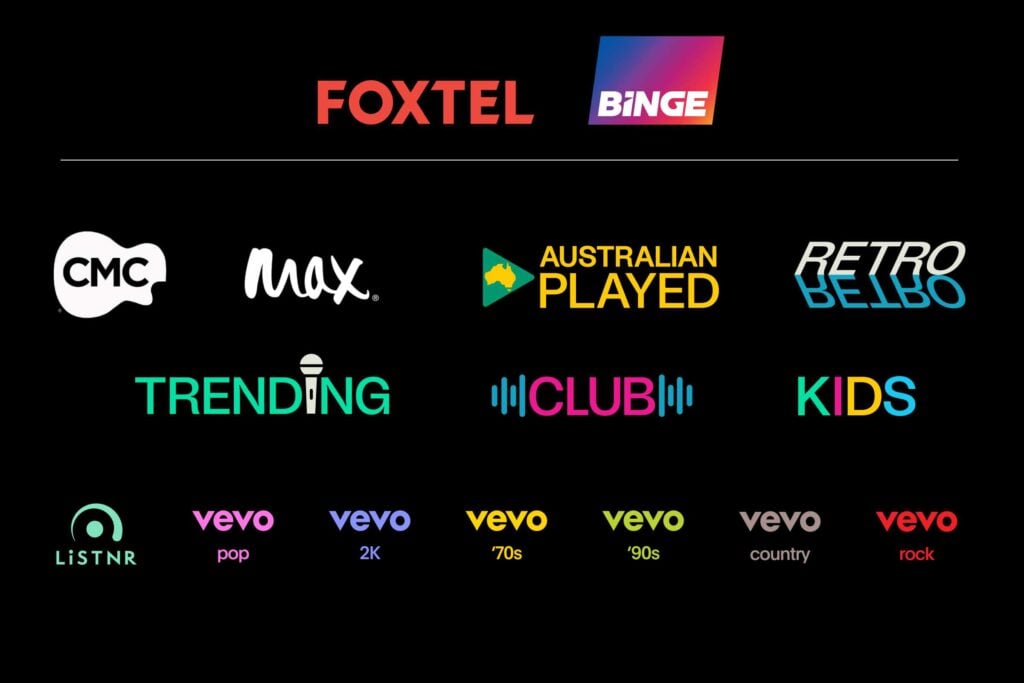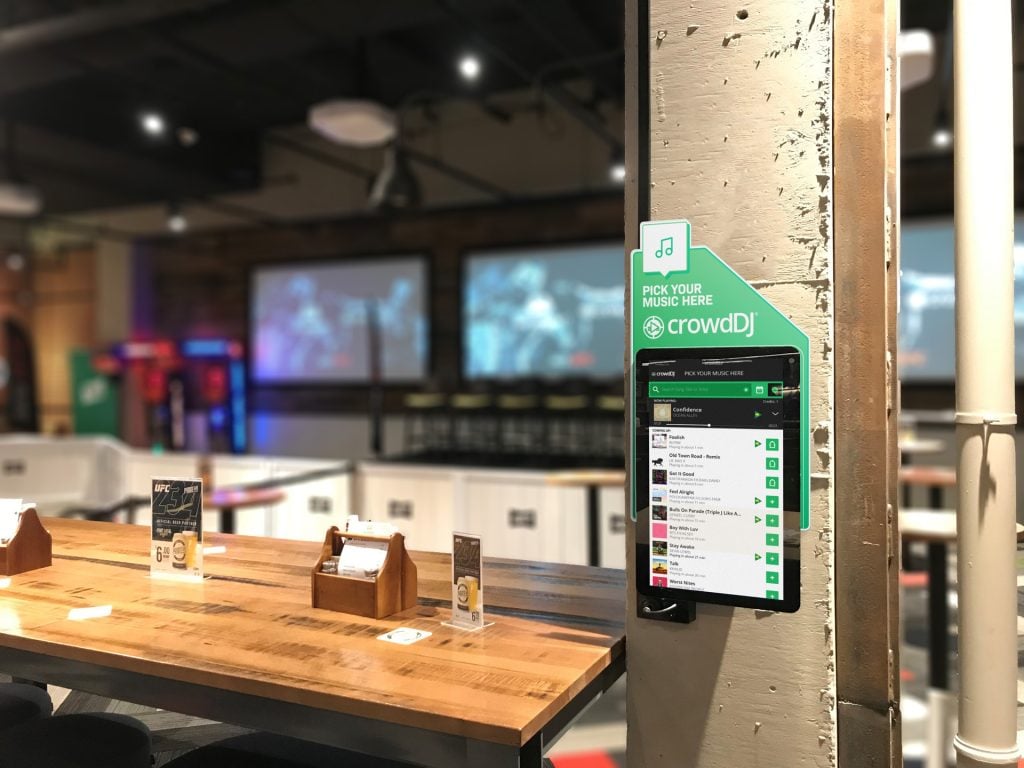Foxtel subscribers were shocked early this month when news broke that from the end of June, MTV Hits, Nick Music, MTV Club, MTV 80s, and CMT were leaving the service. There was no public announcement about a replacement.
Behind the scenes, however, Foxtel was working with a new partner to launch a brand new suite of music channels on the service. The new partner has never run TV channels before, but has decades of music curation experience.
From 1 July, venue music video provider Nightlife Music will manage the content on the Foxtel music video channels. Even staff at the company are surprised if you know the company by name.
For over 25 years, Nightlife Music has provided the soundtrack to Australians having a night out in pubs, clubs, pool halls, and gyms. It boasts an expert curation experience when it comes to highly engaging, deep-library music video. What it doesn’t have is even a minute of experience when it comes to producing linear broadcast channels. It is the perfect, least-likely candidate to take on Foxtel’s music video suite of channels.
The new music video channels
The Foxtel-owned Max and CMC brands are returning to Foxtel. They will be part of a set of seven music video channels, all programmed by the team at Nightlife:
• Trending (ch.801): A mix of top pop hits and predictions, plus what’s trending in the charts and on TikTok.
• Kids (ch.802): Kids in the morning, tweens in the afternoon and teens in the night—featuring the Wiggles, Disney, and clean pop.
• Club (ch.803): The best of dance, club and electronic.
• Retro (ch.804): The greatest hits from the 70s, 80s and 90s.
• CMC (ch.805): Nothing but country hits, all day and all night.
• Max (ch.806): Easy listening classics and contemporary hits.
• Australian Played (ch.807): Aussie artists only, featuring iconic classics, popular hits and the best emerging talent.
These channels will be available on both Foxtel and BINGE from 1 July 2025.

Stephanie Quinn, Foxtel Group Executive Director, Content & Commercial Partnerships told Mediaweek: “Music has always been an important part of the Foxtel entertainment experience. When the chance came to reimagine our music offering, we knew we didn’t want something generic—we wanted something truly impactful.
“Through Foxtel’s Commercial Premises business, we were already familiar with Nightlife, who are synonymous with commercial venues and are respected industry experts. It made perfect sense to partner with them, given their deep roots in the Australian music scene and stellar reputation.
“This innovative partnership has allowed us to deliver a fresh, authentic music experience—not just on Foxtel, but now expanding to BINGE as well. We’re excited to bring even more great music to our audiences across our platforms.”
Foxtel customers (Foxtel IP connected iQ4+ subscribers) will continue to be able to access the Internet-streamed Vevo channels with two new channel additions. Vevo 70s and Vevo Country are joining Vevo Pop, Vevo Rock, Vevo 90s, and Vevo 2K. Mediaweek notes that the Vevo 80s channel is not a part of the lineup.
Foxtel has new audio channels coming too
SCA’s LiSTNR is on board as Foxtel’s new linear audio partner. It will curate a line-up of 25 audio channels. This includes:
• Triple M’s stations: Classic Rock, Country, 70s, 80s, 90s and 2000s
• Hit Network stations: RnB Fridays Radio, Dance Hits, Blender Beats, Oldskool 80s and 90s Hits and Easy Hits
• Indie & Alt
• Chill and acoustic vibes: Almost Acoustic, RnB Chill, Deep Calm, Chill Pop Hits.
• Good Vibes and Roadtrip Anthems
Stephen Haddad, SCA’s Chief Operating Officer told Mediaweek: “This partnership with Foxtel is a natural extension of our All About Audio strategy, giving audiences more ways to connect with our content whenever and wherever it suits them. It highlights the strength of LiSTNR as an audio brand and the depth of our offering.
“We’re bringing curated music experiences to Foxtel’s audience, tailored to reflect their music preferences, while giving clients access to a highly engaged and differentiated audience. Partnering with Foxtel, a trusted entertainment brand, allows us to extend our reach through a quality platform with a strong connection to its community. It’s an exciting opportunity to grow our footprint, connect in more meaningful ways, and create value for both audiences and advertisers alike.”

SCA’s Stephen Haddad
The launch date for the new linear channels is still TBA, but Mediaweek is advised that they are coming soon.
What is Nightlife Music?
Nightlife Music is not a household name, but it probably should be. When you look up from a frosty beer and see a music video playing on the wall of a pub, it is almost certainly being provided by the 120-person team at Nightlife. The Brisbane-based company has around 7,500 clients nationally across hospitality, fitness, retail, accommodation, leisure, dining, cruising, education, and entertainment.
A recent innovation is the crowdDJ service, which allows venue patrons the ability to add music to the playlist, either by a wall-mounted screen or through the crowdDJ app.

Nightlife knows music, but up until about five weeks ago, it knew nothing about running a TV channel. When Foxtel cold-called them to gauge their interest, Nightlife thought it would be simple enough. Very quickly, the scrappy Brisbane firm discovered they had a pretty significant learning curve.
The team was up to the challenge. Mediaweek spoke with Matthew Lymbury, Nightlife’s Head of Content & Partnerships about what it took to be broadcast TV ready:
Mediaweek: In terms of the technical capabilities here, is there an investment of resourcing that you need to engage in now to be able to provide this?
Lymbury: I’ll be quite candid about this. When we first talked to Foxtel, we imagined using our existing technology in our media players… we’d be able to cover this. But as we went, we discovered bits and pieces of technology in that broadcast land. We had some lessons to learn. The biggest one of those, and it’s mind blowing, is you’re required to caption. We pretty much had to do it by hand. And delivering it is a huge thing.
Being able to include that file next to a music video file, so that Teletext can switch it on and off and be able to deliver that to Foxtel as an actual signal, an SRT output signal that it’d be able to use, that required a lot of technology as well.
So we spent the first couple of weeks of looking at this on a big learning curve of technology. We needed a high quality music video mixed with captioning that you can turn on and off, that has redundancy, is able to be backed up if things fall over quickly, and 24/7 scheduling across seven channels.
We found an amazing company, Amagi – they’re like a whole broadcast studio in a box. Funnily, they’ve never worked with music video really, so it’s been this amazing couple of weeks where we’ve sat down and shared all of our knowledge because we’ve built schedulers and players and all sorts of solutions for music video, but they’ve got the whole broadcast technology and ability to handle all of that captioning and all the different pieces needed for scheduling broadcast-style. Together, we’ve been able to sit down and build this amazing solution.
I was just leaving the office then [Mediaweek spoke with Matthew Lymbury on Friday afternoon, just three and a half days before launch] and we had the channels up and running and they had captions playing in and all the different logos and pieces coming in and across. And it was a real goosebumps moment. It was amazing that in about five weeks, we’ve pulled that together… the full seven stations.
Mediaweek: What sort of support did Foxtel provide you? Did they steer you towards Amagi, for example?
They directed us there and gave us the heads up. But, you know, can I say, I sort of thought they would be hardcore and blunt. They have been the most welcoming, supportive, warm, generous team. And it has felt so much like a partnership.
They have, every day, there’s been four or five of them that we’ve worked with. Their broadcast team and their master control have just been amazing working with us.
I’ve been so impressed with the generosity. They’ve got so much knowledge there.
They’re such a bastion of broadcast that I guess is disappearing. So as the world turns into that quick streaming pop-up channel, you have these guys who are the true professionals with all this knowledge of the broadcast industry.
Mediaweek: Tell us about the Australian music channel Australian Played. Everyone seems excited by it.
That is one of the first things we pitched. We’re really passionate about it at Nightlife. It is completely Australian artists 24/7, which is really exciting.
We’ve worked hard to make sure that artists in Australia can be heard. It’s getting so hard for them to find a way to get, especially a music video out, but even just to get their music out. We’ve had an Australia-first policy for programming for a long time.
Australian Played… actually we’ve got that registered and there’s a website there if you wanna have a look at it. And we really focus on that Australian Played, Australian Paid concept.
In that public performance market, there’s roughly in the vicinity of $150 million or more generated every year from venues paying one music tariff. And that has to go to artists. Now, if those venues are playing Australian content, and if more people are playing Australian content, then those artists get more of that money.
The same flows with the broadcast licensing. If we can get Australian artists played on that channel, well, they’re going to get paid more. What it generates, we think, is roughly around at least three to 10 times that. If people are hearing those artists, then they’re going and listening to them on Spotify, recommending them to their friends, keeping them in playlists that they share, and other people listen to those playlists.
It works amazingly in the gyms. We saw an increase of nearly 30% using crowdDJ. So we know people want to hear Australian.
We have the data, we have the evidence. We know what songs they want to hear and the artists listen to as well. So being able to programme a whole music video channel with Australian artists is great.
Mediaweek: During peak music video in the 80s and 90s there were a lot of clips with extended narratives before the music started. That’s not nightclub or venue friendly. Will we see those clips in full on the new channels?
The way the nightlife system works is we don’t alter the physical clip. So, let’s think about Michael Jackson’s Thriller or something, which goes for over ten minutes.
So we have the full clip, we’ve got the whole Thriller piece, but the Nightlife system has start and finish data points. What we offer for public performance is so different to what we’re going to offer on Foxtel for that residential usage.
They’re stories. And what’s even better is… one of the tracks I was just watching then was the Warumpi Band. It’s a track from the 80s, and it’s filmed out at Warumpi, so outside of Alice Springs. You’re seeing utes and all the clothes and capturing Alice Springs from the 80s, it’s just this whole amazing time capsule piece that you get to watch and see.
Matthew Lymbury’s Top 5
With one of Australia’s leading music video programmers chatting to Mediaweek, it would have been professional negligence to not ask Matthew Lymbury what his five favourite music videos are. He gave us this list, but advises that his opinion shifts by the hour.
